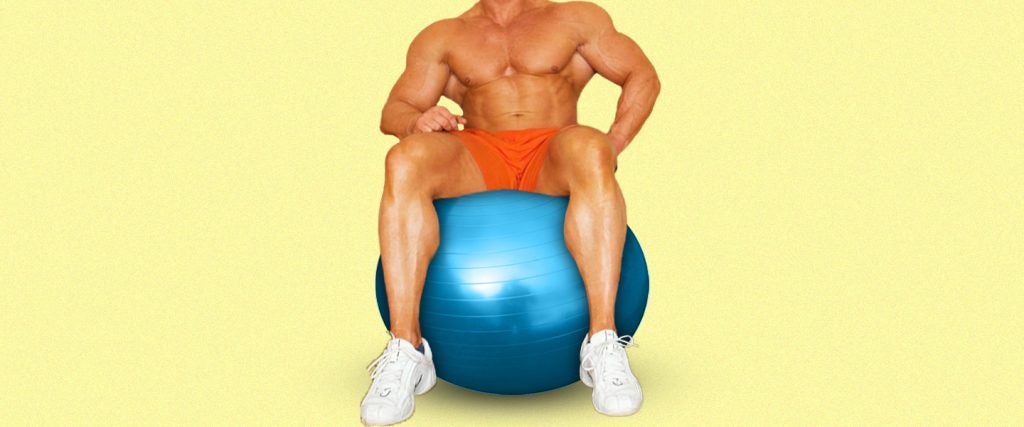While my fellow inbound personal training recruit Amanda and I stood attentively against the wall absorbing every morsel of information being doled out, our personal training director Eddie advised us of all of the ways we should strive to make ourselves irreplaceable to our prospective clients during their instructor-guided first workouts at the Bally Total Fitness Executive Club.
Once he’d finished explaining the concept of “active rest,” and how it could be used to rapidly induce an enhanced sense of fatigue in trainees — ostensibly to upgrade their workouts, but in reality to bring them to the realization that they were altogether unfit and in dire need of a trainer — Eddie moved over to the metal storage rack where the large vinyl stability balls were kept, grabbed one off the top shelf and carried it back over to us.
“Clients love it when you add new equipment into their workouts and show them how to use it,” explained Eddie. “It’s even better when it’s equipment that requires you to be there interacting with them.”
From there, Amanda and I took turns doing leg raises with the ball hooked beneath our heels, followed by dumbbell “bench presses” with our backs resting on the ball and dumbbell deadlifts into curls with the ball positioned between our backs and the wall.
All the while, though, I couldn’t help but notice that I couldn’t press nearly as much weight with the ball as I could on a bench, and a lot of this stuff seemed too easy. In fact, every exercise we did was probably better off without the ball. So much so that I left that session wondering if I’d been transformed into a less effective personal trainer before I’d even gotten started.
Are stability balls actually good for anything?
Absolutely. But they aren’t great for everything, so we need to make sure we’re assessing them fairly.
A stability ball is best thought of as an instability tool. It provides you with a surface that necessitates the initiation of muscle tension as you actively work to retain your balance while you’re on top of it. By lying on a stability ball instead of on the floor or on a bench, there’s a greater element of muscle engagement as the result of interacting with the unstable surface.
In that sense, if you want to optimize your training time, there’s an argument to be made that you can achieve more total muscle engagement and spend longer stretches of time under tension than you would if you were training on a stable surface.
Additionally, the curvature of the stability ball matches the natural arch of the spine, so fully extending your back along it while you execute crunches is less abrasive to the spine than when performing crunches on the floor. Also, in terms of muscle engagement, at least one study has demonstrated that abdominal muscle activity is greater when crunches are performed on a stability ball versus the floor, but only when the ball is correctly positioned along the lower lumbar region of the back.
That sounds great! So why do I feel like there’s a “but” coming?
There’s a big ole “but” coming, the likes of which LL Cool J would compose an opus to commemorate.
And here it is: BUT… what are your actual fitness goals, and how does a stability ball help you achieve them more quickly?
If your optimal goal is to build or maintain strength as efficiently as possible, you’ll rapidly reach a stage where the stability ball isn’t only interfering with the process, but it may even be making things more difficult. And I don’t mean that in the sense that the exercises are now more challenging. Instead, the presence of the ball is making true progression impossible.
Case in point: The act of grasping dumbbells weighing more than 30 pounds for any purpose, even if you fancy yourself a strong individual, shouldn’t be undertaken lightly. A trip, fall or slip with weights in your hands will cause you to rapidly respect the peril present within those bundles of iron. Even 15 unsecured pounds flying through a weight room is potentially deadly, so imagine grabbing a 50-pound dumbbell in each hand and attempting to slide yourself back into a chest-pressing position on a resistance ball, only for you to slip off to the side and send 50 compact pounds crashing onto your cheekbone.
Also, even in terms of direct abdominal engagement, crunches on a stability ball are substantially less engaging to the core than the bicycle crunching maneuver and hanging leg raises, whether they’re performed on a Captain’s Chair or while hanging from a bar. And, yes, stability ball crunches are better for the abdominals and obliques than traditional crunches, but not staggeringly so. When you get right down to it, abdominals are so easily trained with high volume exercise that the difference between a set of abs trained on a ball as opposed to the floor is negligible in the long run.
So is a stability ball worth owning?
If it will make you more likely to hit the ground and work out, then I’d urge you to purchase one ASAP. I’ll gladly accept consistency with above-average exercises over inconsistency with optimal exercises every time — and consistency with substandard exercises will always trump the total absence of exercise.
All I ask is that you be careful how you use a stability ball when you’re holding weights in your hands. And certainly, if you’re in the market for a personal trainer and he approaches you for your initial session with a smile on his face and a stability ball in his hands, be wary. He may be trying to establish his value by luring you in with exercises that are essentially valueless — at least in comparison to what you could be doing instead.

